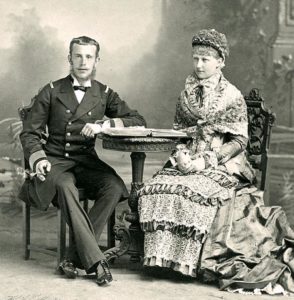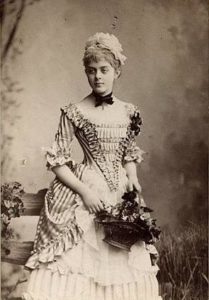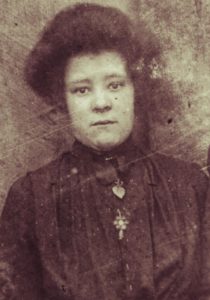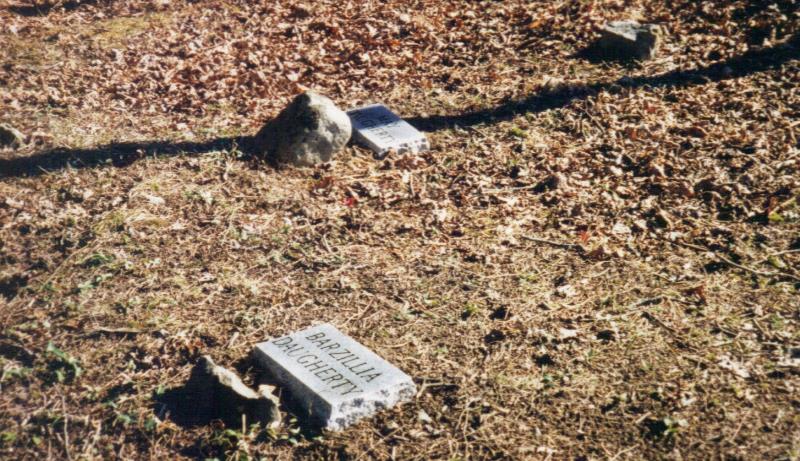“All extremes of feeling are allied with madness.”
from Orlando by Virginia Woolf
Love can be extreme. We labor over deep affections, encourage hopeful prospects, and bend over backwards. Passions rise, hormones rage, and dopamine surges. Eyes are star-filled and grins are wide and heady. Sometimes, love incurs disastrous outcomes. Such was the case in 1889 at a hunting lodge in Mayerling, Austria-Hungary.

The Crown Prince of Austria, Archduke Rudolf, was in an unwanted arranged marriage with Princess Stéphanie of Belgium. The union was ultimately an unhappy one. Consequently, he drank too much liquor and indulged in many affairs. One fine evening in 1887, a twenty-nine-year-old Rudolf attended a lavish ball in Germany and met his future beloved mistress, seventeen-year-old Baroness Marie Alexandrine Freiin von Vetsera. The couple had a passionate affair.

Rudolf petitioned his father, Kaiser Franz Joseph I, to allow him a divorce so he could marry Marie. The Kaiser said divorce was inconceivable and demanded his son end the affair. Rudolf and Marie traveled to his hunting lodge in Mayerling, enjoyed a lovely private dinner, and, sometime in the evening, allegedly entered into a “suicide pact.” They had one last rendezvous, after which Rudolf summarily retrieved a pistol, turned to his sleeping lover, positioned the weapon securely against her pretty head, then shot and killed her. Next, he put the gun to his own head and killed himself (image of him lying in state).
Love can certainly be extreme. Sometimes affections become dangerously obsessive and controlling. A baby was born halfway across the globe the same year Rudolf and Marie acted on that death pact. Though status, place, and circumstance were different, she, too, would be shot to death by a man who claimed to love her.

Barzilla Daugherty was born in March of 1889 to Joseph H. Daugherty and Ellen Duncan Daugherty.1)Barzilla was born in either Anderson County or Scott County, Tennessee. She and her family lived in Scott County, Tennessee. Mountain men typically worked any job they could find. According to the 1900 Census, her father worked as a farmer. By 1920, he was a coal miner.
Barzilla had long, dark hair and piercing dark eyes. In the only image I’ve seen of her, she is dressed conservatively, almost orthodox, with a high neck collar. Her hair is brushed up in a Gibson girl fashion. Her collar appears to be adorned with a heart-shaped pin or necklace, below which hangs a flower charm. Her face is full and her expression is pleading. The picture is quite haunting. She married the handsome, tall, and slender Harrison Armes on October 13, 1905, in Morgan County, Tennessee. She was sixteen years old; he was seventeen. Harrison worked as a farmer, though his 1917 draft registration says he worked for a timber company. The Armes’s had two children: Ola May and Frazier. They may have had a third child: Calley.
Unfortunately, divorce was just around the corner for Barzilla and Harrison. The 1920 census had her back home living with her parents. Robbie Wilson on Find-a-Grave reveals Barzilla and Harrison divorced in June, 1920. The reason for divorce seems unclear, but, if Mr. Wilson’s date rings true, Harrison remarried not even one month after the divorce was final on July 3, 1920.2)Harrison married Roxie Patterson in Morgan County, Tennessee. He remained married to her until he died in 1967. Given his speedy marriage to a new wife, one could speculate a reason for the breakup with Barzilla.
A few months after Harrison’s new marriage, Barzilla made the fateful decision to tie the knot with widower Granville Bunch on September 18, 1920.3)Barzilla and Granville married in Morgan County, Tennessee. Granville was a “typical Southern mountaineer” who lived with his parents and spent a good portion of his life working “in the coal mines of East Tennessee.”4)Nashville Tennessean 4/10/1922 “Bunch, Who goes to Chair on Tuesday, Takes Fate Calmly” The couple’s relationship seems to have been rocky, because, less than a year after the nuptial, Barzilla and her children went back to live with her parents. A crucial event after the separation hints at a possible reason.
For Barzilla, Sunday, September 4, 1921, likely began like any other day. She and her mother would rise before dawn. Chickens and hogs had to be fed, eggs gathered, fire lit for the woodburning stove, biscuit dough rolled, cut, and baked, etc. Many chores were done before the children rose from their straw or rope beds. If not, they were up and at ‘em right alongside her. That her parents allowed her to return home again and live with them is, in my opinion, a testament to the close relationship they had. Not perfect, mind you. But they were certainly there for her when she needed them.
Sometime that day, Granville Bunch made his way to the Daugherty household, madder than a hornet. He likely made his way close to the house and yelled his wife’s name. Newspaper sources claim he demanded she return jewelry, clothing, and any other items he’d purchased for her. She met him somewhere down the road from the house and returned the items. He further demanded she return the clothes “and other articles of wearing apparel” on her person.5)Nashville Tennessean 4/10/1922 “Bunch, Who goes to Chair on Tuesday, Takes Fate Calmly” I’m uncertain as to why she took off her clothes and I don’t know if she stripped bare. I can only assume she was ordered to do so at gunpoint and tried to appease Bunch.
After she returned the items, Bunch piled them in the middle of the road, struck up a timber, and lit the entire heap ablaze. Barzilla must’ve walked off, perhaps inched away slowly, because he soon ran to her and tried to force her to come back to him. Sources say he “demanded that she go and live with him.”6)Nashville Tennessean 4/10/1922 “Bunch, Who goes to Chair on Tuesday, Takes Fate Calmly” She refused, turned, and fled. He followed his escaping wife down the road, swiftly aimed his sights dead at her back, then shot and killed her. He then aimed the gun at his head and pulled the trigger . . . but survived.
Granville Bunch was arrested, tried, and subsequently found guilty on February 26, 1922. But officials noticed something was a little “off” about him. He claimed amnesia, saying he could not remember events that led up to the shooting and had “no knowledge of his arrest, trial or conviction.”7)Nashville Tennessean 4/10/1922 “Bunch, Who goes to Chair on Tuesday, Takes Fate Calmly” He only regained his memory some three months later, after being transferred to the Tennessee State Prison in Nashville.
His execution was scheduled for April 11, 1922. In jail, he was quite lackadaisical about his fate. During his imprisonment, his only visitor, aside from a few officials and clergymen, was a reporter for the Nashville Tennessean. The reporter attested that Bunch spoke of his fate “as if it were as inevitable as his hunger or his thirst.”8)Nashville Tennessean 4/10/1922 “Bunch, Who goes to Chair on Tuesday, Takes Fate Calmly” Further, the reporter wrote that Bunch spoke
. . . in a strangely incoherent, disjointed manner . . . His deportment might either have been that of a man dazed by a blow, or of a moron.9)Nashville Tennessean 4/10/1922 “Bunch, Who goes to Chair on Tuesday, Takes Fate Calmly”
No family or friends came to visit Granville Bunch during his imprisonment. When ministers came to visit and pray with him, Bunch seemed oblivious to their presence. Prison officials and administrators said he just “stared blankly at those about him.” When the visiting reporter asked why his family hadn’t visited, Bunch said they were all “too busy.”10)Nashville Tennessean 4/11/1922 “Bunch Prepares to Die, Still Pleading Lapse of Memory”
Some people were certain Bunch’s behavior indicated he was either insane or mentally challenged. He had suffered a self-inflicted head wound. An appeal for a stay of execution was made on his behalf to Tennessee Governor Alfred Taylor. Secretary to the governor, Abe L. Garrison actually visited and spoke with Bunch. Garrison left convinced that “Bunch’s claim of lapse of memory . . . [was] a thorough fraud.”11)Nashville Tennessean 4/11/1922 “Bunch Prepares to Die, Still Pleading Lapse of Memory” Ultimately, the governor refused a stay of execution.
Bunch was frank at times about his relationship with Barzilla. He said he had “wanted to join the church and live right”12)Nashville Tennessean 4/10/1922 “Bunch, Who goes to Chair on Tuesday, Takes Fate Calmly” but hadn’t because of Barzilla’s bad influence. He said of his wife,
I loved her; I tried to please her every way. But she wouldn’t stay with me. Her folks took her away from me.”13)Nashville Tennessean 4/10/1922 “Bunch, Who goes to Chair on Tuesday, Takes Fate Calmly”
He believed her family worked to separate them so “she could marry another mine worker” with more money.14)Nashville Tennessean 4/10/1922 “Bunch, Who goes to Chair on Tuesday, Takes Fate Calmly” Bunch also spoke to the reporter about the greatest injustice done to him:
‘Justice has not been done to me,’ [he said, rehashing] an occasion in his youth, when a grand jury had refused to issue an indictment against someone who had shot him, or at him; and this he seemed to consider the greatest injustice done him in his life.”15)Nashville Tennessean 4/10/1922 “Bunch, Who goes to Chair on Tuesday, Takes Fate Calmly”
On the execution morning Bunch’s demeanor was markedly different. He had been calm and nonchalant about receiving no visitors in prison. That morning, however, he seemed acutely distressed by that fact. He lamented that he had been deserted and said “‘humanity has turned its back on me.’”16)The Knoxville News 4/11/1922 “‘There Is No God’ Cries Murderer, As He Goes to His Death in Chair” He fought and wrestled with prison officials as he was led to the chair. He yelled, “There is no God!”17)The Knoxville News 4/11/1922 “‘There Is No God’ Cries Murderer, As He Goes to His Death in Chair” and said he regretted being baptized in prison a few days prior.
Granville Bunch was executed by electric chair on April 11, 1922 at 5:57 a.m. He was pronounced dead at 6:00 a.m. He was the “eighth man electrocuted in Tennessee”18)St. Louis Post Dispatch March 24, 1922 “Seven Executions for County in Two Months: Granville Bunch to be Electrocuted at Knoxville, Tenn., April 11 for Murder of Wife” within two months. He was the 19th man executed overall in the state. His body was unclaimed, though Robbie Wilson on Granville’s Find-a-Grave site, wrote the following underneath a newspaper clipping image:
Granville’s brother Noah was going to ride the train to Nashville so he could claim the body and ensure its return to the family in Anderson County, but he lost the train fare (for the return of Granville’s body) at a poker game en route to the train depot in Oliver Springs hence the reason Granville’s body wasn’t claimed.
Granville was buried at Spring Hill Cemetery. His internment was paid for by “several Nashville citizens, who have asked that their names be withheld.”19)UNKNOWN NEWSPAPER
Granville’s idea of love was obsessive and controlling. But we should not allow the dramatic events surrounding his murderous choice to obscure the fact that Barzilla Daugherty Armes Bunch was a strong, hard-working mountain woman. She brought beautiful children into this world and was a fiercely protective mother. But she lived and died a harsh mountain reality. Women were to remain voiceless and accept their lot. She doesn’t appear to have done so. Barzilla was buried in a simple grave just across from her daughter May at Beech Grove Cemetery in Fork Mountain, Anderson County, Tennessee.20)Fork Mountain was at one time known as Daugherty Mountain21)Not much is known about May – her birthdate, death date, etc. The marker is flat and simple, with just her name. Her given name is spelled “Barzillia,” either a misspelling or a name she was called by family.22)My great-great grandmother was named Parzida Lowe Goodman. I had always been told the pronunciation was Parsidia. Her surname on the stone is “Daugherty,” not Armes, not Bunch, but “Daugherty,” a fact that’s pretty telling to me. Indeed, after her death, her children were taken in by her mother and father, Joe and Ellen Daugherty, and given the Daugherty surname. Even in death, Barzilla refused to be anyone but who she was proud to be – a Daugherty.

**Featured Image by Noelle Otto on Pexels – altered, cropped
The following sources were used for this article:
- ancestry.com – Flatt, Madison, ed. 1922. “Bunch to be Buried by Private Subscription.” April 13.
- Espy, Jr. M. Watt. 1987. “Legal Executions in the American South 1880-1935.” Capital Punishment Research Project, Headland, Alabama.
- M.E. Grenander Special Collections and Archives. 1922. Bunch, Granville. ESPY Records, Knoxville: archives.albany.edu.
- Marriage Bonds and License, Morgan County Court. 1905. Harrison Armes and Barzilla Daugherty. Marriage License, Morgan County: State of Tennessee.
- Marriage Record, Morgan County, Tennessee. 1920. Granville Bunch and Barzilla Daugherty. Marriage Bond, Morgan County: State of Tennessee .
- Morgan County Press. 1920. “Marriage Licenses.” Morgan County Press, July 9: Front.
- Nashville Tennessean. 1922. “Bunch, Who goes to the Chair on Tuesday, Takes Fate Calmly.” Nashville Tennessean, April 10: Front, 3.
- —. 1922. “Bunch Prepares to Die, Still Pleading Lapse of Memory.” Nashville Tennesseean, April 11: Front.
- Oxford English Dictionary. n.d. “Love.” Oxford English Dictionary. Accessed May 2022.
- Setterfield, Ray. 2021. “Lovesick Prince in Suicide Pact.” On This Day. Jan 20.
- St. Louis Post-Dispatch. 1922. “Seven Executions in County for Two Months: Granville Bunch to be Electrocuted at Knoxville, Tenn., April 11 for Murder of Wife .” St. Louis Post-Dispatch, March 24: 28.
- State of Tennessee Marriage Record. 1920. Harrison Armes and Roxie Patterson. Marriage License, Morgan County: State of Tennessee.
- State of Tennessee, State Board of Health. 1922. Granville Bunch. Certificate of Death, Nashville: State of Tennessee Bureau of Vital Statistics.
- The Knoxville News. 1922. “Brief News of E. Tennessee.” The Knoxville News, April 10: 3.
- —. 1922. “‘There is No God,’ Cries Murderer, as He Goes to His Death in Chair.” The Knoxville News, April 11: Front.
- United States Armed Forces. 1917. Harrison Armes. Registration Card, Morgan County: United States Armed Forces.
- United States Federal Census. 1900. “12th Census of the United States.” United States Federal Census, Scott County, Tennessee.
- United States Federal Census. 1920. “Fourteenth Census of the United States.” United States Federal Census, Morgan County.
- United States Federal Census. 1920. “Fourteenth Census of the United States.” Unijted States Federal Census, Anderson County.
- United States Federal Census. 1910. “Thirteenth Census of the United States.” United States Federal Census, Morgan County.
- Wilson, Find-a-Grave – Robbie, ed. 1922. “Without One Friend to Bid Him Goodbye Granville Bunch is Executed Early This Morning.” April 11.
References
| ↑1 | Barzilla was born in either Anderson County or Scott County, Tennessee. |
|---|---|
| ↑2 | Harrison married Roxie Patterson in Morgan County, Tennessee. He remained married to her until he died in 1967. |
| ↑3 | Barzilla and Granville married in Morgan County, Tennessee. |
| ↑4, ↑5, ↑6, ↑7, ↑8, ↑9, ↑12, ↑13, ↑14, ↑15 | Nashville Tennessean 4/10/1922 “Bunch, Who goes to Chair on Tuesday, Takes Fate Calmly” |
| ↑10, ↑11 | Nashville Tennessean 4/11/1922 “Bunch Prepares to Die, Still Pleading Lapse of Memory” |
| ↑16, ↑17 | The Knoxville News 4/11/1922 “‘There Is No God’ Cries Murderer, As He Goes to His Death in Chair” |
| ↑18 | St. Louis Post Dispatch March 24, 1922 “Seven Executions for County in Two Months: Granville Bunch to be Electrocuted at Knoxville, Tenn., April 11 for Murder of Wife” |
| ↑19 | UNKNOWN NEWSPAPER |
| ↑20 | Fork Mountain was at one time known as Daugherty Mountain |
| ↑21 | Not much is known about May – her birthdate, death date, etc. |
| ↑22 | My great-great grandmother was named Parzida Lowe Goodman. I had always been told the pronunciation was Parsidia. |








![Nashville Tennessean. [FRONT PAGE Clipping- Bunch Prepares to Die . . .]. 11 Apr 1922, 1.350 scenes darken effects classic hot fudge](https://wp-modula.b-cdn.net/spai/q_glossy,ret_img,w_375,h_830/https://www.appalachiabare.com/wp-content/uploads/2022/05/Nashville-Tennessean.-FRONT-PAGE-Clipping-Bunch-Prepares-to-Die-.-.-..-11-Apr-1922-1.350-scenes-darken-effects-classic-hot-fudge.jpg)



Granville was my great grandfather. Of course, I never knew him. His daughter Viola was my grandmother. She married John Seeber in Frost Bottom. They had an only son…Clayton, my father.
Hello Matt. Thank you for commenting on my Barzilla Daugherty article. We would love to hear more about your family’s story. Please feel free to contact me with questions, concerns, or send a story of your own at my email: delonda@appalachiabare.com.